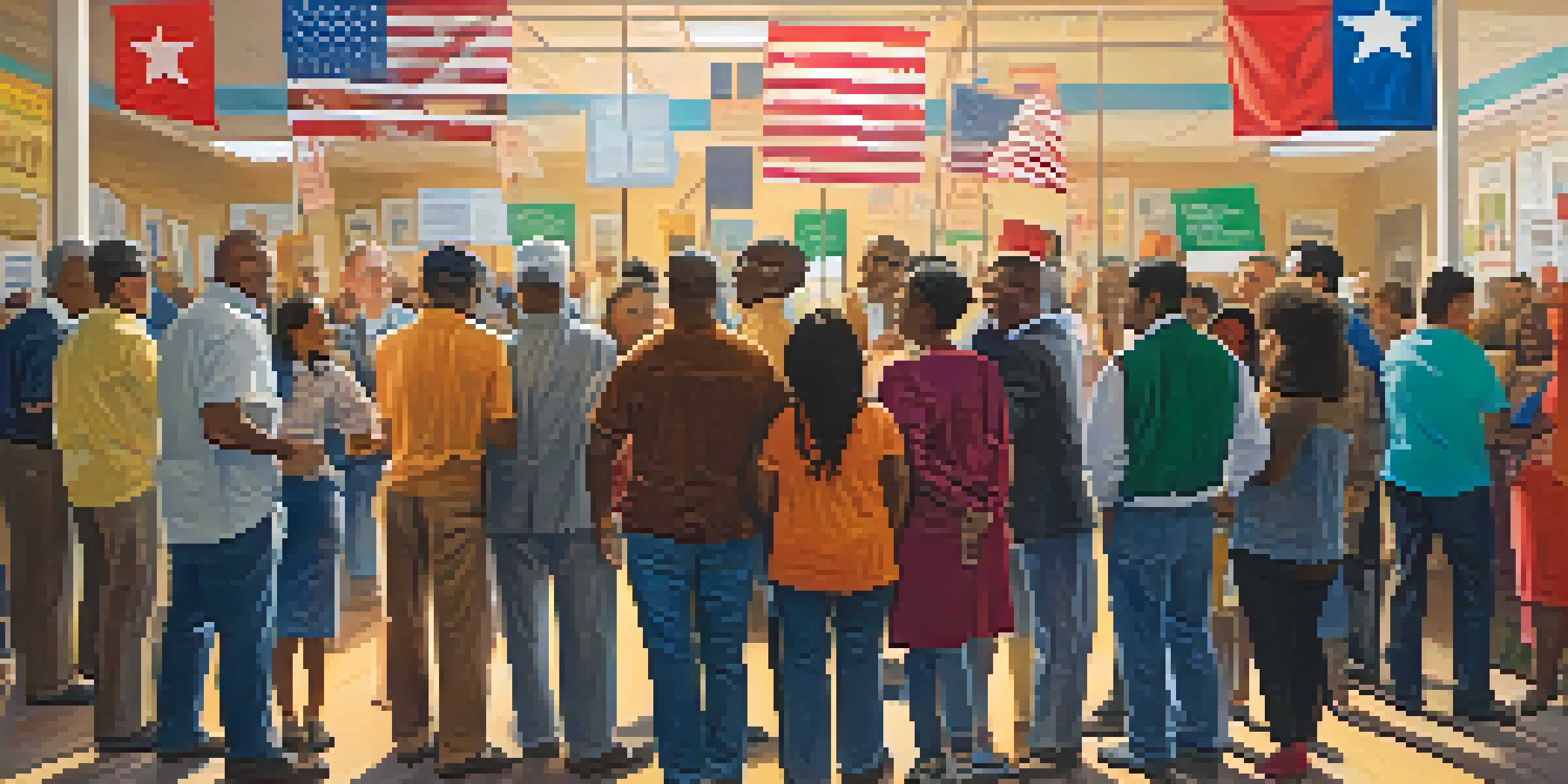Voter Demographics and Their Influence in Texas Elections

The Diverse Landscape of Texas Voter Demographics
Texas is known for its rich cultural diversity, which is reflected in its voter demographics. The state's population includes a mix of ethnicities, ages, and socioeconomic backgrounds, each contributing to the electoral process. This diversity impacts not only who votes but also the issues that resonate with various groups. For instance, Hispanic voters make up a significant portion of the electorate, influencing policies and candidates that prioritize immigration and education.
The strength of a nation derives from the integrity of the home.
In addition to ethnic diversity, Texas has a wide range of age groups participating in elections. Younger voters often lean toward progressive issues, while older generations may focus on traditional values and fiscal responsibility. Understanding these generational divides helps political parties tailor their messages to appeal to different voter bases, ensuring their relevancy in a rapidly changing political landscape.
Moreover, socioeconomic factors play a crucial role in shaping voter turnout. Individuals from lower-income backgrounds may face challenges that affect their voting participation, such as transportation barriers or time constraints due to multiple jobs. Recognizing these issues can help organizations and campaigns develop strategies to reach and engage these voters effectively.
The Role of Education in Shaping Voting Patterns
Education is a fundamental factor influencing voter behavior in Texas. Higher educational attainment often correlates with increased voter engagement and participation in elections. Educated voters tend to prioritize issues like climate change, healthcare reform, and social justice, which can significantly sway election outcomes. Understanding this connection allows campaigns to focus on issues that resonate with educated demographics.

Conversely, lower educational attainment is sometimes associated with lower voter turnout. This can be due to a lack of awareness about the voting process or feeling disconnected from political issues. Campaigns that aim to increase voter participation among less educated communities can benefit from targeted outreach efforts, such as informative workshops and community events that simplify the voting process.
Texas Voter Diversity Matters
The rich cultural, age, and socioeconomic diversity of Texas voters significantly influences electoral outcomes and the issues that resonate with different groups.
In recent elections, candidates have recognized the importance of addressing educational disparities. By promoting policies that support education access and affordability, they can not only attract educated voters but also engage those who may feel marginalized. This strategy not only empowers individuals but also strengthens the electoral process as a whole.
Geographic Trends in Texas Voting Behavior
Geographic location plays a significant role in influencing voter demographics in Texas. Urban areas like Houston and Dallas tend to lean Democratic, driven by younger, more diverse populations. In contrast, rural regions often support Republican candidates, reflecting more traditional values and concerns. This geographic divide creates a dynamic electoral landscape where candidates must navigate varying interests.
In a democracy, the people get the government they deserve.
Furthermore, suburban areas have become battlegrounds in recent elections, showcasing shifting voting patterns. As more people move to the suburbs, these areas are becoming increasingly diverse, with a blend of urban and rural influences. Candidates must adapt their strategies to address the unique issues faced by suburban voters, such as education, transportation, and local economy.
Recognizing these geographic trends is essential for political campaigns. By understanding the specific needs and concerns of different regions, candidates can tailor their messages and outreach efforts. This localized approach not only fosters a deeper connection with voters but also enhances the overall electoral strategy.
The Influence of Age on Texas Voter Turnout
Age is a critical factor in determining voter turnout in Texas elections. Younger voters, particularly those aged 18 to 29, are often less likely to participate compared to their older counterparts. This demographic tends to be more progressive, advocating for issues such as climate action and social equity. Engaging younger voters is vital for fostering a more representative electoral process.
On the other hand, older voters, particularly those over 65, typically have higher turnout rates. This group often prioritizes issues like healthcare and retirement security, which can significantly influence election outcomes. Candidates that understand these priorities can effectively address the concerns of older voters, ensuring they feel represented in the electoral conversation.
Education Affects Voting Behavior
Higher educational attainment often leads to increased voter engagement, with educated voters prioritizing issues like climate change and social justice.
To boost turnout among younger voters, campaigns can leverage social media and grassroots movements. By creating engaging content and providing information on how to vote, campaigns can empower younger generations to make their voices heard. This approach not only increases participation but also cultivates a more engaged electorate for future elections.
The Impact of Ethnicity on Voting Preferences
Ethnicity profoundly impacts voting preferences in Texas, as different cultural backgrounds bring unique perspectives and priorities to the electoral table. For instance, Latino voters often emphasize issues such as immigration reform and education, while African American voters may focus on social justice and economic equality. Understanding these preferences enables candidates to align their platforms with the values of these communities.
Additionally, Asian American voters in Texas are becoming an increasingly influential demographic. With diverse backgrounds and experiences, their voting preferences can vary widely, making it essential for candidates to engage this group thoughtfully. By addressing the specific concerns of Asian American voters, candidates can build a more inclusive platform that resonates across cultural lines.
Ultimately, political campaigns that prioritize ethnic diversity and inclusivity can foster stronger connections with voters. By recognizing and respecting the unique needs of different communities, candidates can create a more equitable electoral process that reflects the true fabric of Texas.
Socioeconomic Status and Voting Behavior in Texas
Socioeconomic status plays a critical role in shaping voting behavior in Texas. Individuals from higher-income backgrounds are often more engaged in the electoral process, influenced by factors such as access to education, resources, and networks. They may prioritize issues like tax cuts and business initiatives, which can sway election outcomes significantly.
Conversely, lower-income voters may face barriers to participation, such as lack of transportation or time constraints. This can lead to lower turnout rates among these demographics, which can skew election results. Addressing these barriers through community outreach and support can empower lower-income individuals to become more active participants in the electoral process.
Geography Shapes Voting Trends
Urban, suburban, and rural areas in Texas exhibit distinct voting behaviors, requiring candidates to tailor their campaigns to address localized concerns.
Campaigns that focus on socioeconomic disparities can create more inclusive platforms. By advocating for policies that address income inequality, affordable housing, and access to healthcare, candidates can resonate with a broader audience. This not only helps in garnering support but also fosters a more equitable political environment.
The Role of Political Parties in Shaping Voter Engagement
Political parties play a pivotal role in shaping voter engagement in Texas. Each party has its unique approach to reaching out to different demographics, tailoring messages and campaigns to resonate with specific groups. For example, Democrats often focus on social issues and inclusivity, while Republicans may emphasize economic growth and traditional values. Understanding these strategies helps voters navigate the political landscape more effectively.
Moreover, party affiliation can influence voter turnout. Individuals who identify strongly with a political party are more likely to participate in elections, driven by a desire to support their candidates. This loyalty can be bolstered by effective party outreach, community engagement, and mobilization efforts leading up to elections.

As Texas continues to evolve, political parties must adapt their strategies to engage diverse voter populations. By understanding the unique needs and concerns of different groups, parties can foster stronger connections and encourage greater participation in the electoral process. Ultimately, this can lead to a more vibrant and representative democracy.